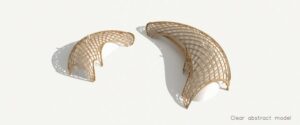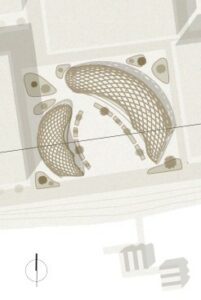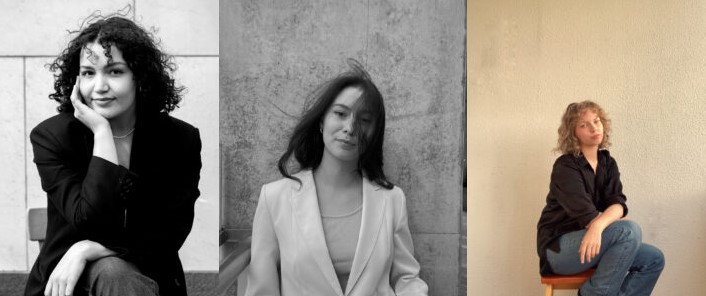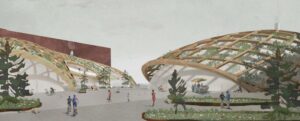Nora Petersen, Laura Salminen & Amanda Puerto-Lichtenberg
What has sparked your interest in participating in the ATELIER student competition?
Nora Petersen: For me it was my teammates enthusiasm for this competition that made me want to participate.
Laura Salminen: My interest in the Atelier student competition was sparked during our excursion trip to Denmark. Although I wasn’t yet aware of the competition, I got to visit numerous sites including CopenHill by BIG. The architecture serves as both a functional structure and a harmonious environment for both humans and nature, with its infrastructure concealed under its mountain-like exterior. This will be more common as sites become increasingly scarce in the future. I was inspired to explore innovative and enjoyable solutions for these types of spaces to naturally attract people.
Amanda Puerto-Lichtenberg: For a long time, I had been eager to participate in an architecture competition. The ATELIER competition sounded like the perfect way to start, since the theme of combining social city spaces with technical buildings was interesting, the amount of material to submit was reasonable and intriguing with the video, and the Copenhagen site was close to my heart.

Why did you decide to submit a group application instead of participating individually?
Nora Petersen: We had been talking for some time now about doing a competition together, and this felt like the right time for it.
Laura Salminen: We were actively searching for a competition to participate in and when we came across this particular one, it felt like the perfect fit for us. The format of creating a concept caught our attention. It offered a sense of freedom and allowed us to search for ways to bring our countless ideas into a cohesive whole. We knew we wanted to work together on a competition and combine our individual perspectives and strengths.
Amanda Puerto-Lichtenberg: Laura and Nora are my closest friends that I have gotten to know during my architecture studies. We work well together both on a professional and personal level. I admire their passion for architecture and wanted to learn from their way of working and thinking. In our studies we do a lot of individual work, so it was also fun to try out a real team project!
For your concept, you could choose between Bratislava or Copenhagen as demonstration site. Based on which criteria did you make your choice?
Nora Petersen: We chose Copenhagen, because since all of us had been there it was easier to design a concept that fits the city.
Laura Salminen: The Copenhagen site held a special significance for us and almost felt like a natural choice. We felt drawn to it and the site itself provided us abundant inspiration. During our collective excursion through Denmark, we had the opportunity to explore the local architecture, appreciate the beautiful nature and interact with people. We wanted to create something we felt the people of Copenhagen would enjoy.
Amanda Puerto-Lichtenberg: For me personally Copenhagen is close to my heart since I’m born there and am attached to the city in many ways. As a team we were intrigued about working with a site connected to the water, since we think it offers a lot of possibilities. We also liked that the site already had some existing life and we wanted to embrace that with our design.
Where did you take inspiration for your idea?
Nora Petersen: We had many inspirations along the way, but for me my core inspiration was the idea of art. There is this certain awe when you see an installation or street graffiti in a place that you didn’t expect. I wanted to evoke that feeling.
Laura Salminen: It was evident to us from the beginning that we wanted to design a pavilion and a pop-up space that would integrate the preferred activities of the visitors to this site. We envisioned the shape to be lite and airy and deliberately contrasting with the surrounding structures. While searching for our shape we viewed several existing pavilions, observed popular urban areas where people naturally gravitate towards and drew inspiration from multiple organic shapes and patterns found in art and photographs.
Amanda Puerto-Lichtenberg: We started collecting inspiration by analyzing the site thoroughly. We studied the patterns of movement, the surrounding architecture and atmosphere. Through various iterations we studied the opposites and utopistic visions that we would like to incorporate in the city scape. I would say that visually we were mostly inspired by lanterns and see-through structures, as well as organic and artistic shapes that seem to be in motion and leave an open space between them.

What was the biggest challenge in coming up with an innovative concept?
Nora Petersen: I would say the most challenging thing was not to get hung up on the idea of innovative. I feel like that when there is pressure to design something new and radical, you kind of box yourself in. You too easily cast aside the ideas that feel mundane and in the search of something innovative you can end up with something impractical.
Laura Salminen: Initially, we went in a whimsical direction, aiming to merge all our ideas together in our brainstorming phase. However, we soon encountered the challenge of finding practical ways to incorporate technology beneath our shell while maintaining an open and customizable site. We turned to a more rational approach, where we evaluated what was possible for the technological side. This took us further from our starting vision but while revising the materials we reminded ourselves that realistic utopia remained our main focus. Ultimately, our journey allowed all the pieces to align and come together.
Amanda Puerto-Lichtenberg: The biggest challenge was finding the balance between large and intimidating technical buildings and empathetic, easily approachable, human-centered gathering spaces. Making a new landmark while trying to disturb the existing inhabitants and surrounding architecture was not easy. Also reaching the middle-ground between a building that represents both “realistic utopia” and is “economically and practically feasible” was very challenging.
Were there any challenges in combining individual ideas/concepts/images of each Team member to create a joint concept?
Nora Petersen: Not really. Of course, we didn’t feel the same way about every idea, but we went through them together and the end result represent all of us very naturally.
Laura Salminen: Our visions intertwined quite well together so the challenge in combining these aspects was more down to our design skills. We worked on our ideas closely from the very beginning, holding meetings and working together on campus. I think the challenging part was when we had to narrow down our possibilities based on rationality. As a result, the combination of ideas took a form of its own moving further from the cohesive piece we had envisioned.
Amanda Puerto-Lichtenberg: Creating a joint concept was not difficult in our team. Since the beginning we set our goals and values straight, and luckily, they matched quite perfectly. Under the process we went back and forth between ideas that were shared and made sure to always remain encouraging but critical. We also asked our friends to give us a mid-project review, to have outsiders’ perspective on our process. In the end I feel like our concept wasn’t born through mixing different ideas – it evolved as one.

How can you see yourself benefitting from this task/experience for future projects/concepts?
Nora Petersen: I can see myself benefiting from this immensely. I would say rarely do you get the change to design something like this and the design progress taught me a lot. It taught me how make a teamwork successful and how I play as a team player. This experience also gave me new insight on how you can elevate the mundane.
Laura Salminen: I can already see how this process will benefit me in my future projects. I have gained valuable insight into collaborating closely with a great team and witnessed how an idea forms from multiple minds. The scheduling and time management were well-organized, allowing us to grasp the necessary time for each design phase. In group work, there is a constant reflection on ideas, where your ambitious concept can be caught by others and collaboratively shaped into something tangible.
Amanda Puerto-Lichtenberg: This task has taught me mostly about working with a team and being able to present your own ideas and discuss them from various points-of-view clearly and convincingly. Being critical to my own visions and learning to ask critical questions about my teammates’ ideas was crucial. In future projects I will have a clearer idea of how to follow a schedule and combine the work pace and style of various people.
Are there any lessons learned in regard to creating a concept for multi-functional technical buildings?
Nora Petersen: I would say the simpler the better. Especially in the Copenhagen case where the site is in the middle of the city because something flashy and radical could clash with the urban space. Our concept to house pop-up spaces is fairly simple and it has been done many times, but this simple idea works with the organic shape and surrounding urban structure.
Laura Salminen: Based on our experience the lesson learned is to evaluate the requirements of the technical aspects without allowing them to overshadow the study of human behavior and the dynamics of nature. It is important to find a balance between the logical structure and our innate understanding to create something that feels more relatable and connected to us.
Amanda Puerto-Lichtenberg: I learned that to make multifunctional technical buildings, there should be the possibility to offer some sort of indoor space. There is very little open indoor public spaces in our cities, and that would be a way to encourage a lot of year-round activities. When it comes to the technical parts, I think leaving enough space, and creating multiple layers of structure around the technical core is also a good way to deal with noise or smells besides creating architecturally interesting areas for people, nature and art.

